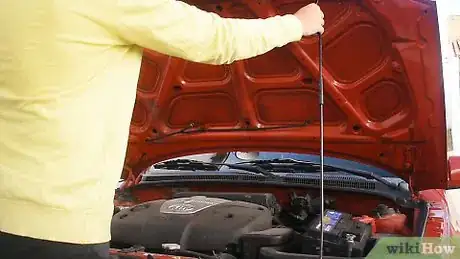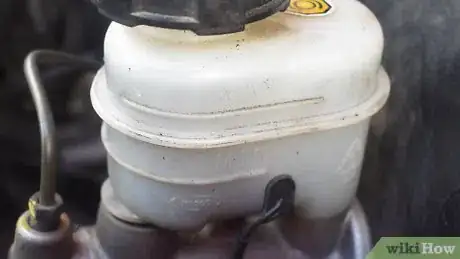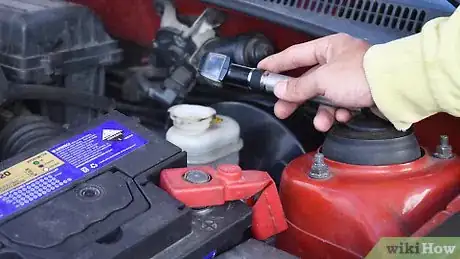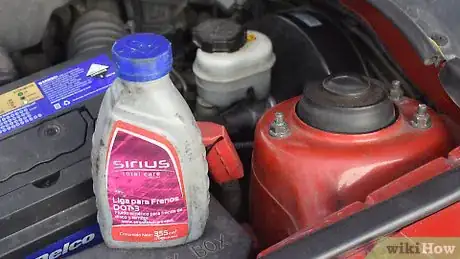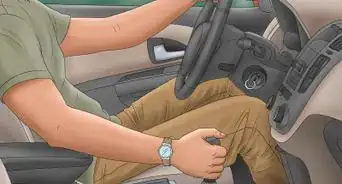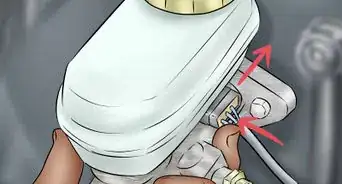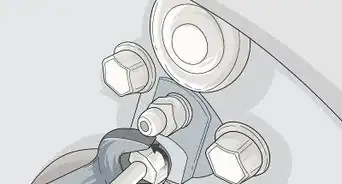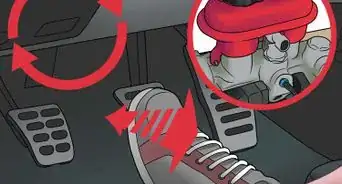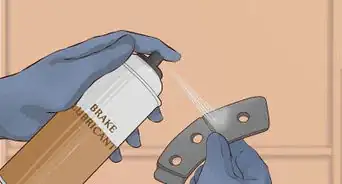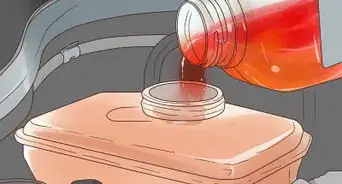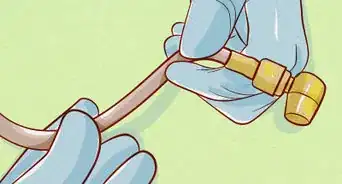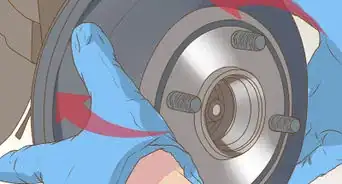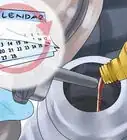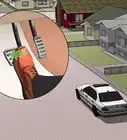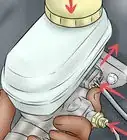This article was co-authored by Ed Beery. Ed Beery is an Automotive Specialist and the Owner of InTechgrity Automotive Excellence based in Denver, Colorado. With more than eight years of experience, he specializes in providing maintenance and repair services for both individuals and companies. Ed and the InTechgrity Automotive Excellence Team are approved by the American Automobile Association (AAA) for repairs and are Automotive Service Excellence (ASE) certified.
There are 13 references cited in this article, which can be found at the bottom of the page.
This article has been viewed 343,189 times.
Your car's brake system is one of several automotive hydraulic systems. When you push down on the brake pedal, fluid is delivered through the brake lines from the master cylinder to the brake drums or discs, slowing the car through friction. To make the system work properly, you need to have enough brake fluid in the system, and it needs to be in good enough condition to do its job.
Steps
Checking the Brake Fluid Level
-
1Open the car's hood.[1] It's best to do this when the car is stopped on a level surface, with the engine cold.
-
2Look for the master cylinder.[2] On most cars, the master cylinder is located at the back of the engine bay, on the driver's side. There's a reservoir above the cylinder itself.Advertisement
-
3Check the fluid level in the reservoir.[3] On most newer cars, the reservoir is transparent, with lines marked "Min" and "Max"; the brake fluid level should fall between these lines. Cars older than the 1980s may have metal reservoirs, requiring you to remove the reservoir cap. (Newer caps screw on and off, while some older caps need to be pried off with a screwdriver.)
-
4Add brake fluid to the reservoir if required. Pour the fluid carefully into the reservoir, wiping up any spills, as brake fluid is toxic and corrosive.[4]
- Use only the brake fluid with the DOT specification recommended in your owner's manual. There are three main specifications: DOT 3, DOT 4 and DOT 5, each having its own properties. It is possible to use DOT 4 brake fluid in some cars that call for DOT 3 fluid, but never the reverse, and DOT 5 brake fluid can be used only in cars that call for that specification. Note that most cars indicate the required brake fluid DOT at the reservoir cap.
- This is also a good time to check how well the reservoir cap seals.
-
5Replace the reservoir cap and close the hood.[5]
- If the brake fluid level is significantly below the "Min" or "Add" line, you should have your brakes inspected for excessive wear. As brake pads wear down, brake fluid can channel itself out of the brake lines into the calipers.[6]
- It is also possible to have the brake fluid reservoir full and not have the brake fluid reaching the master cylinder. If your brakes feel spongy even with the reservoir full, take your car to a mechanic.
Checking the Brake Fluid Condition
-
1Check the brake fluid color. Normally, brake fluid is brown. If the fluid looks dark or black, it may need to be replaced but further testing is needed.[7]
-
2Dip a chemical test strip into the fluid.[8] As brake fluid ages, its corrosion inhibitors break down. Test strips check the presence of copper in the brake fluid; the higher the level, the more worn out the inhibitors are. One such test strip is Phoenix Systems' "Brake Strip Brake Fluid Test Strip"
-
3Test for moisture content with an optical refractometer.[9] Brake fluid is hygroscopic, which means that over time, it absorbs moisture from its surroundings. Moisture dilutes and weakens the effectiveness of brake fluid, which leads to braking systems components to corrode. In 18 months, brake fluid can have up to 3 percent water, which can lower its boiling point from 40 to 50 percent.
-
4Evaluate the brake fluid's boiling point with an electronic tester. New DOT 3 specification brake fluid is to have a dry boiling point of 401 degrees Fahrenheit (205 degrees Celsius) and a wet boiling point of 284 degrees (140 degrees Celsius), while DOT 4 fluid is to boil at 446 degrees (230 degrees Celsius) dry and 311 degrees (155 degrees Celsius) wet. The lower the point at which the brake fluid boils, the less effective it is.
- Your mechanic should have both an optical refractometer and electronic brake fluid tester to perform these tests for you as part of an automotive checkup.
Community Q&A
-
QuestionMy brakes don't squeal but my pedal goes to the floor. What is the issue?
 Community AnswerYou may have bad linkage or the brake fluid may be low on a more modern car.
Community AnswerYou may have bad linkage or the brake fluid may be low on a more modern car. -
QuestionShould the engine be hot or cold when I'm checking the brake fluid?
 Community AnswerIt doesn't matter, although you might feel more comfortable if the engine is cold.
Community AnswerIt doesn't matter, although you might feel more comfortable if the engine is cold. -
QuestionWhat color should the brake fluid be?
 Logic Johnson LafontaineTop AnswererIf it's new, it can be clear or amber. As it gets older, it will turn closer to brown.
Logic Johnson LafontaineTop AnswererIf it's new, it can be clear or amber. As it gets older, it will turn closer to brown.
Warnings
- In addition to seeing your brake or ABS warning light come on, if your brake pedal feels too hard or spongy, goes down too far, makes noise, drags or pulsates, or if your car pulls to one side or gives off a burning smell while braking, take the car in for servicing.⧼thumbs_response⧽
Things You'll Need
- Bottle of brake fluid
- Funnel (optional)
- Rag or paper towel
References
- ↑ https://www.dummies.com/home-garden/car-repair/how-to-raise-your-vehicles-hood/
- ↑ https://www.dummies.com/home-garden/car-repair/brakes-bearings/how-to-check-a-vehicles-brake-fluid/
- ↑ https://www.military.com/off-duty/autos/brakes-checking-brake-fluid.html
- ↑ https://owner.ford.com/support/how-tos/vehicle-care/brakes/how-to-check-and-add-brake-fluid.html
- ↑ https://youtu.be/UEWR_sYcULg?t=89
- ↑ https://www.dummies.com/article/home-auto-hobbies/automotive/car-repair-maintenance/general-car-repair-maintenance/how-to-check-a-vehicles-brake-fluid-196461/
- ↑ http://www.myautorepairadvice.com/brake-fluid-color.html
- ↑ https://www.familyhandyman.com/automotive/car-brakes/how-to-check-brake-fluid/
- ↑ https://www.ebay.com/motors/blog/how-to-check-your-cars-brake-fluid/
About This Article
To check your vehicle’s brake fluid, start by opening the hood and finding the master cylinder, which is toward the back of the engine bay on the driver’s side. Then, look at the reservoir next to it and check if the fluid falls between the “Min” and “Max” lines on the container. If it’s below the minimum, carefully add more fluid. Also, check the color of the brake fluid to make sure it's brown and not black. If it looks black, you may need to replace it. For tips on how test your brake fluid if you think it needs to be changed, read on!
